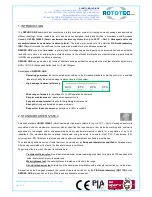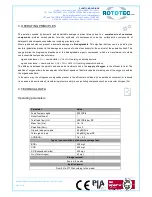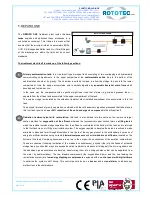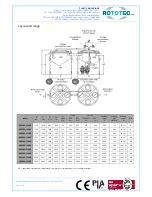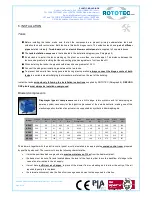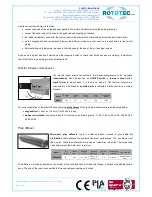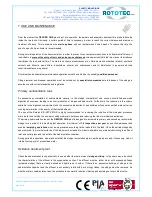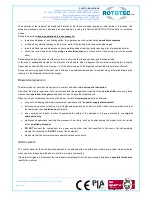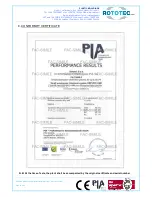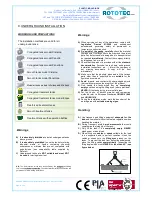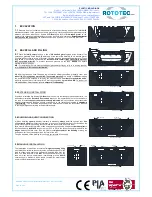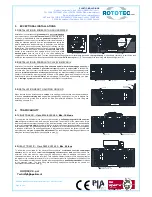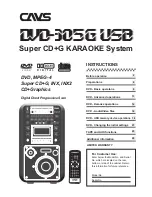
PLASTIC MOULDINGS
V
IA DELL
’
ARTIGIANATO
,
6
•
61026
LUNANO
(PU)
•
I
TALY
T
EL
.
+39
0722
722801
•
F
AX
+39
0722
70599
•
W
EB
:
www.rototec.it
E-
:
•
PEC
VAT
and TAX
CODE
01476690415
•
C
OMPANY
C
APITAL
.
120.000,00
CCIAA
(C
HAMBER OF
C
OMMERCE
R
EG
.
N.)
12602
P
ESARO
DEPURO ONE Use and Maintenance Manual, Rev. 00 of 27/01/2016
Page 4 of 13
OUTLET
INSTALLATION DIAGRAM
5. DEPURO ONE
The DEPURO ONE treatment plant inside the two
tanks exploits and optimises these processes in a
controlled environment. This it does in a manner that
ensures that the principal reference parameters BOD
5
,
COD, SS (Suspended Solids) and N
tot
(Total Nitrogen)
at the discharge are within the limits set by current
standards.
The treatment plant itself is made up of the following sections:
-
Primary sedimentation tank: is a true Imhoff type biological tank consisting of two overlapping and hydraulically
communicating compartments. In the upper compartment the sedimentable solids drop to the bottom of the
sedimentation chamber by gravity. The chamber is suitably inclined to allow the sludge to pass into the lower
compartment. Here the sludge accumulates and is partially digested by anaerobic bacterial micro flora which
develops and remains active.
In the same way, the components with a specific weight lower than that of water (e.g. oils and greases, foam,...)
separate from the effluent and accumulate in the upper compartment of the tank.
The surplus sludge recirculated by the oxidation treatment plant installed downstream also accumulate in this first
tank.
The physical process of gravity separation, combined with the cold anaerobic digestion processes that take place in
this first tank, result in an over 50% reduction of the solid and organic component in the effluent itself.
-
Oxidation treatment plant with recirculation: this tank is also divided into two sections: the lower and larger
section provides for oxygenation of the effluent, whereas the (successive) upper section forms a stilling tank in
which the residual surplus sludge separates from the effluent, accumulates at the bottom of the tank, and is returned
to the first tank via an air-lift type recirculation system. The oxygen required to develop the aerobic reactions is made
available in dissolved form through dissolution in the liquid of the oxygen present in the atmosphere, by means of
energetic artificial aeration using suitable blowers/compressors and micro-bubble air diffusers, located on the
bottom of the tank. Complex phenomena are set up in the oxygen-rich environment of the aeration compartment.
These are chemical (chemical oxidation of the malodorous substances), physical (the jelly-like flakes of activated
sludge trap any solids that may have escaped primary treatment) and above all biological (the micro-organisms use
the dissolved organic substances to develop, transforming them into a living substance that can be separated from
the water by sedimentation). The two blowers/compressors (the oxygenation blower and the one feeding the
recirculation system) are low-energy diaphragm compressors equipped with a control panel with digital timers
to optimise the system on/off timing. This control panel also has a buzzer and a visual alarm to indicate any
malfunctions in the compressors.
1.
2.


